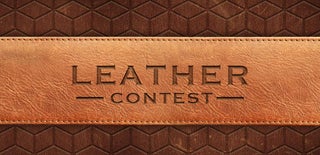Introduction: Revolver Holster With Bullet Band
Revolver holster with bullet band that holds six additional rounds
REMINDER CAUTION: make sure that the revolver is UNLOADED before handling, and always practice SAFETY when handling any firearm
Ask your parent or guardian for help if under aged
Ask for help if needed or unsure
Step 1: Supplies
Large leather pieces, one of 4-5mm for the holster, and one that is thinner (2mm) to shape for the bullet band, as it will require a lot of bending (the thickness and size is dependent on your project, and always have more than you need)
REMEMBER: the thicker the leather the more sturdy but harder to shape and bend, the thinner is easier to shape and bend but is not as sturdy
Leather cord, or heavy duty string to use as a tie-down
Hole punches
Rivets
Needle and wax thread (whatever color you want)
Cutting tools (utility cutter)
Pencil
Small anvil
Angle iron
Ballpein hammer
Whatever tools you think are necessary
Step 2: Cutting
Take the thicker of the two leathers, mark out the basic design and cut it out (you can find some designs online to trace and cut or you can create your own)
What I did was mark the belt loop to come out from behind the cylinder, while cutting the top of the holster to end above the hammer
Make sure that you leave some extra leather at the bottom, so the revolver does not stick out, and you can punch a hole for the tie-down, later on
Step 3: Forming
Wrap your revolver in cellophane to keep water out
Wet the spine and face of the leather (the part that will be showing from your leg)
Keep the inner face that goes against your leg dry, so that the revolver lies flat against your leg
Place the gun in leather and press down with weights, or something heavy, to form the leather around the revolver
Let dry for a few hours, or until it is shaped how you want it
Step 4: Rivets and Cutting
Punch a hole for the rivets at the bottom and top
Snap the rivets into place but do not hammer them shut yet because you will need to be able to take them in and out
Follow the curve of the leather where you molded the revolver and cut along that edge, you can leave more than needed as you can go back later and cut more off if you want
For the belt loop cut straight up and behind where the revolver will go
I cut the front of the holster so that the top of the leather covers the cylinder, part of the trigger guard and the hammer of the revolver
Step 5: Bullet Band
At this point you want to stop work on the holster and begin making the bullet band
The bullet band I am making will carry six rounds, as that is how many the revolver will hold at one point, but you can make it hold however many you would like
Using the thinner leather cut a strip of leather approximately an inch wide, or however thick is needed to fit around the ammunition casing
Then cut another strip the same width
Make sure both pieces are long enough to work with as you can cut off any excess that you have when finished
Step 6: Sewing the Band Together
To start, lay one piece on top of the other and punch three ( or as many as you want) holes on the inside edge of the end bullet
Sew the leather together using the punched holes, to help keep both pieces of leather even, and to form a snug fit around each bullet
DO NOT sew the ends, or stich the holes between bullets three and four, as you will use these places to sew your band onto the holster
Step 7: Sewing Continued
Fit the leather around the bullet next to your stitching and taking your punch create three more holes just on the other side
Remember, DO NOT sew the ends, or stich the holes between bullets three and four, as you will use these places to sew your band on the holster
Continue until you have as many bands on the belt as you need or want
Step 8: Bullet Band Sewing
At this point you will want to punch the holes for the bullet band
I set this band to be at a small angle to help keep the bullets from sliding out in case of an accident
Punch the holes at the top of the holster where you will sew the band, lining up the top and bottom of the band holes to be sewn to the holes you punched in the holster
Sew the top of the band on, then punch the holes for the middle part of the band to sew on
Once the middle of the band is sew, punch the holes for the bottom part of the band and sew it all together
Once the band has been sewn on there should be six loops to hold the six extra rounds of ammunition
Step 9: Tie-Down Hole
Before riveting (or sewing) your holster together punch a hole near the bottom of the holster where the barrel goes
I put the hole where the holster goes against my leg, but near the spine so that when I add the tie-down, the knot or loop will not rub against my leg as I move
Step 10: Riviting
Instead of sewing the edge together, I decided to rivet it as I feel it makes the edge stronger, and I appreciate how it looks
At this point put in the top and bottom rivets that you had punched earlier and hammer them into place
I placed the rest of my rivets about three quarters of an inch apart, but you can space them however you want, just be careful not to place them too far apart
I would punch a hole then hammer a rivet in place, then punch the next hole, to ensure a tight fitting and to keep the holster shaped correctly
If you have any extra leather along the edge you can cut it off now
Step 11: Revolver Strap
Instead of using a strap I decided to use a leather tie with a Sam Browne Button
Have the revolver in the holster to measure where a tie will be most appropriate I choose right above the trigger guard, and the button is placed to be out of the way of the bullet band
After marking the spots punch two holes
Leave the hole empty on the backside of the holster, insert a Sam Browne Button on the front of the holster
Step 12: Leather Tie Strap
Take some leather string and loop one end back over, make sure that the loop will fit snug around the Sam Browne Button, but can slide on and off
Glue the strip together except the loop and then tie waxed string around the glued part to help keep it together
Thread the leather string through the hole on the belt loop piece, and tie it off however long is needed to fit over the revolver and keep it firmly secured in the holster
Step 13: Belt Loop
Using a piece of leather or belt figure out how low you want your holster to hang, and how wide you need to make the belt loop
I choose to have the revolver hang about even with my pocket
Once you have decided, punch two holes around the belt to rivet, to create the loop
Rivet the loop together with as many rivets as you want or need to create a sturdy loop
Alternatively, the loop can be sewn shut if rivets do not appeal to you
Step 14: Tie Down
Take some leather string and loop it through the hole at the bottom of the holster
Make sure to have enough string to be able to tie around your leg
Step 15: Finishing
To finish the holster I just oiled it to give it a used look and to protect it from the elements
I left the edges rough but you can smooth them out
A lot of the holster can be left up to the imagination, you can put in you own designs, stains, and create a holster that is unique to yourself
Take your time and enjoy what you create
It took approximately three to four hours to complete, but was spread over two days to allow the holster to form around the revolver at the beginning

Participated in the
Leather Contest 2017

Participated in the
Hand Tools Only Contest 2017













